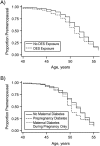Association of intrauterine and early-life exposures with age at menopause in the Sister Study
- PMID: 20534821
- PMCID: PMC2915484
- DOI: 10.1093/aje/kwq092
Association of intrauterine and early-life exposures with age at menopause in the Sister Study
Abstract
Oocytes are formed in utero; menopause occurs when the oocyte pool is depleted. The authors hypothesized that early-life events could affect the number of a woman's oocytes and determine age at menopause. To test their hypothesis, the authors conducted a secondary analysis of baseline data from 22,165 participants in the Sister Study (2003-2007) who were aged 35-59 years at enrollment. To estimate the association between early-life events and age at natural menopause, the authors used Cox proportional hazards models to estimate hazard ratios with 95% confidence intervals, adjusting for current age, race/ethnicity, education, childhood family income, and smoking history. Earlier menopause was associated with in-utero diethylstilbestrol exposure (hazard ratio (HR) = 1.45, 95% confidence interval (CI): 1.27, 1.65). Suggestive associations included maternal prepregnancy diabetes (HR = 1.33, 95% CI: 0.89, 1.98) and low birth weight (HR = 1.09, 95% CI: 0.99, 1.20). Having a mother aged 35 years or older at birth appeared to be associated with a later age at menopause (HR = 0.95, 95% CI: 0.89, 1.01). Birth order, in-utero smoke exposure, and having been breastfed were not related to age at menopause. In-utero and perinatal events may subsequently influence age at menopause.
Figures


Similar articles
-
Association of intrauterine and early-life exposures with diagnosis of uterine leiomyomata by 35 years of age in the Sister Study.Environ Health Perspect. 2010 Mar;118(3):375-81. doi: 10.1289/ehp.0901423. Environ Health Perspect. 2010. PMID: 20194067 Free PMC article.
-
Association of In Utero Exposures With Risk of Early Natural Menopause.Am J Epidemiol. 2022 Mar 24;191(5):775-786. doi: 10.1093/aje/kwab301. Am J Epidemiol. 2022. PMID: 35015807 Free PMC article.
-
The association between in utero cigarette smoke exposure and age at menopause.Am J Epidemiol. 2008 Mar 15;167(6):727-33. doi: 10.1093/aje/kwm351. Epub 2008 Jan 11. Am J Epidemiol. 2008. PMID: 18192675
-
Early life factors for endometriosis: a systematic review.Hum Reprod Update. 2020 Apr 15;26(3):412-422. doi: 10.1093/humupd/dmaa002. Hum Reprod Update. 2020. PMID: 32141508
-
The effect of adverse intrauterine conditions, early childhood growth and famine exposure on age at menopause: a systematic review.J Dev Orig Health Dis. 2018 Apr;9(2):127-136. doi: 10.1017/S2040174417000952. Epub 2017 Dec 4. J Dev Orig Health Dis. 2018. PMID: 29198238
Cited by
-
Vitamin D3 Ameliorates DNA Damage Caused by Developmental Exposure to Endocrine Disruptors in the Uterine Myometrial Stem Cells of Eker Rats.Cells. 2020 Jun 12;9(6):1459. doi: 10.3390/cells9061459. Cells. 2020. PMID: 32545544 Free PMC article.
-
Associations between birthweight and preterm birth and the ages at menarche and menopause.BMC Womens Health. 2024 Oct 3;24(1):546. doi: 10.1186/s12905-024-03384-6. BMC Womens Health. 2024. PMID: 39363289 Free PMC article.
-
Developmental reprogramming of myometrial stem cells by endocrine disruptor linking to risk of uterine fibroids.Cell Mol Life Sci. 2023 Aug 31;80(9):274. doi: 10.1007/s00018-023-04919-0. Cell Mol Life Sci. 2023. Update in: Sci Prog. 2023 Oct-Dec;106(4):368504231215601. doi: 10.1177/00368504231215601. PMID: 37650943 Free PMC article. Updated.
-
Prenatal exposures and anti-Mullerian hormone in female adolescents: the Avon Longitudinal Study of Parents and Children.Am J Epidemiol. 2013 Nov 1;178(9):1414-23. doi: 10.1093/aje/kwt137. Epub 2013 Sep 5. Am J Epidemiol. 2013. PMID: 24008900 Free PMC article.
-
Fetal programming and cardiovascular pathology.Compr Physiol. 2015 Apr;5(2):997-1025. doi: 10.1002/cphy.c140036. Compr Physiol. 2015. PMID: 25880521 Free PMC article. Review.
References
-
- Matthews KA, Wing RR, Kuller LH, et al. Influence of the perimenopause on cardiovascular risk factors and symptoms of middle-aged healthy women. Arch Intern Med. 1994;154(20):2349–2355. - PubMed
-
- Cummings SR, Melton LJ. Epidemiology and outcomes of osteoporotic fractures. Lancet. 2002;359(9319):1761–1767. - PubMed
-
- den Tonkelaar I, te Velde ER, Looman CW. Menstrual cycle length preceding menopause in relation to age at menopause. Maturitas. 1998;29(2):115–123. - PubMed
-
- Soules MR, Sherman S, Parrott E, et al. Executive summary: Stages of Reproductive Aging Workshop (STRAW) Fertil Steril. 2001;76(5):874–878. - PubMed
-
- Gougeon A, Chainy GB. Morphometric studies of small follicles in ovaries of women at different ages. J Reprod Fertil. 1987;81(2):433–442. - PubMed
Publication types
MeSH terms
Substances
Grants and funding
LinkOut - more resources
Full Text Sources
Medical

